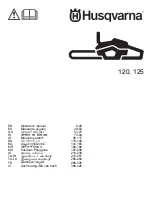
STIHL 029, 039
39
5.1.2
Ignition Module
5.1.2.1
Ignition Timing
5.1.2.2
Removing and Installing
Top:
1 = Spark plug terminal
2 = Ignition lead retainer
3 = Groove
Bottom:
1 = Lead retainer
2 = Short circuit wire
1 = High voltage output
2 = Connector tag
The ignition module accommodates
all the components required to control
ignition timing. There are two
electrical connections on the coil
body:
1. the high voltage output
2. the connector tags for the short
circuit wires
Accurate testing of the ignition
module is only possible with
sophisticated test equipment. For
this reason it is only necessary to
carry out a spark test in the work-
shop. A new ignition module must be
installed if no ignition spark is
obtained (after checking that wiring
and stop switch are in good
condition).
- Remove handle housing - see
- Pull terminal off the spark plug.
- Remove the ignition lead from
the retainer and groove on the
cover.
- Pull the short circuit wire off the
tag on the ignition module and
remove it from the lead retainer.
Ignition timing on the electronic
(breakerless) magneto ignition
system is fixed at 2.4 mm (0.095")
B.T.D.C. at 8,000 r.p.m. and is not
adjustable.
However, in view of the permis-
sible tolerances in the electronic
circuit, it may vary between 2.0
and 2.8 mm (0.080" and 0.11 ")
B.T.D.C. at 8,000 r.p.m.
Since there is no mechanical wear in
these systems, ignition timing cannot
get out of adjustment. However, an
internal fault in the circuit can alter the
switching point in such a way that a
spark test will still show the system to
be in order although timing is outside
the permissible tolerance. This will
impair engine starting and running
behavior.
















































